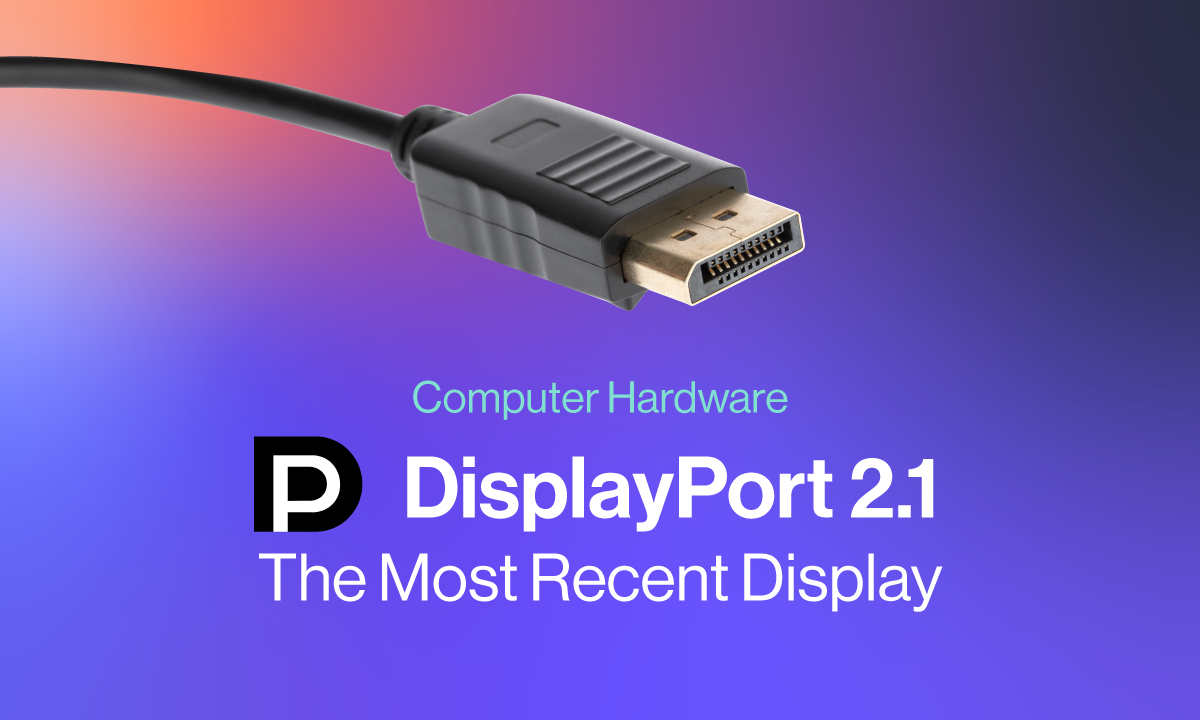When was DisplayPort Released?
DisplayPort 2.1 was released in 2022 and was adopted by a couple of products on the market, namely the new AMD Radeon RX7000 and AMD Radeon PRO W7000 Series GPUs. In 2025 NVIDIA announced the release of the RTX 50-series GPUs that also now support the DisplayPort 2.1 standard. A big value proposition for these GPUs is the future-proofing for displays, adding DP 2.1 alongside the existing HDMI 2.1 port. Post-launch of AMD's last generation GPUs and before the release of NVIDIA's RTX 50-series, more and more monitors have been released with DisplayPort 2.1 support. In this blog, we will discuss the key differences in DisplayPort 2.1 including bitrate, peak resolutions, peak refresh rates, and relevance to HDMI 2.1.
Quick Background on Display Connectors DisplayPort and HDMI
HDMI, arguably the more popular sibling, is an audio-visual interconnect developed in 2002 to replace and improve upon DVI. It combines video and audio in a smaller unified port and also ended up replacing VGA, red, yellow, white Component, and other forms of video output cables. HDMI became the standard for connecting media devices to a video output.
DisplayPort or DP is also an audio-visual interconnect developed in 2006 to replace the blocky white VGA cables on computers and monitors. It differs from HDMI by using a packetized data transmission, a form of digital communication used in Ethernet, USB, and PCIe. From the start, DisplayPort has always been able to deliver more data, thus supporting higher resolutions at higher refresh rates than HDMI. DP is more common on Desktops, Workstations, and Laptops for connecting to monitors. TVs have continued to use the HDMI standard.
What is DisplayPort 2.1
DisplayPort 2.1 is the newest iteration and a major improvement to the widely used DP 1.4 by supporting triple the total bandwidth thanks to new transmission modes UHBR 10, UHBR 13.5, and UHBR 20. Ultra High Bit Rate numerical values denote the per-lane data rate of the connection, which in DP is multiplied by 4 lanes.
Transmission Modes | Certification Level | Bandwidth | Data Rate | DP 1.4 | DP 2.1 |
|---|---|---|---|---|---|
RBR (1.62 Gbit/s) | Standard VESA-Certified | 6.48 Gbit/s | 5.18 | ✅ | ✅ |
HBR (2.70 Gbit/s) | Standard VESA-Certified | 10.80 Gbit/s | 8.64 | ✅ | ✅ |
HBR2 (5.40 Gbit/s) | Standard VESA-Certified | 21.60 Gbit/s | 17.28 | ✅ | ✅ |
HBR3 (8.10 Gbit/s) | DP8K Cable | 32.4 Gbit/s | 25.92 | ✅ | ✅ |
UHBR10 (10 Gbit/s) | DP40 Cable | 40.00 Gbit/s | 38.69 | ❌ | ✅ |
UHBR 13.5 (13.5 Gbit/s) | DP80 Cable | 54.00 Gbit/s | 52.22 | ❌ | ✅ |
UHBR 20 (20 Gbit/s) | DP80 Cable | 80.00 Gbit/s | 77.37 | ❌ | ✅ |
The increased bit rate transmitted over the DP 2.1 enables higher resolutions, increased HDR, and support for even higher refresh rates. Since the data transfer rates are still capped, there is a tradeoff between resolution and refresh rate at uncompressed. Below is a table of resolutions and the refresh rates each type of DisplayPort can handle based on speed and protocol. We used common refresh rates, with pluses to signify that the peak is beyond current monitor technology limits.
Peak Resolutions | HBR3 (DP 1.4) | UHBR 10 | UHBR 13.5 | UHBR 20 |
|---|---|---|---|---|
1080p (1920x1080) | 500Hz | 500Hz+ | 500Hz+ | 500Hz+ |
1440p (2560x1440) | 240Hz | 360Hz | 480Hz | 500Hz+ |
4K (3840x2160) | 120Hz | 144Hz | 240Hz | 300Hz |
5K (5120x2880) | 60Hz | 60Hz | 120Hz | 180Hz |
8K (7680x4320) | 30Hz | 30Hz | 60Hz | 60 - 85Hz |
Monitors that support 2.1 are scarce but starting to be released. There are ways to utilize DP 2.1 and that's with very large, high resolution, multi-displays plugged into the same port via multi-stream transport or MST, but that multi-display setups can be delivered using a video wall controller.
It is also important to keep in mind, not all DisplayPort 2.1 connectors and cables are the same. Some may only be capable of up to UHBR 10, some UHBR 13.5, and others the full fat UHBR 20. Here’s a list of available GPUs and their respective DisplayPort specifications:
- AMD Radeon RX 7000-series (3x DP 2.1 UHBR 13.5, 1x HDMI 2.1)
- AMD Radeon PRO 7000 (3x DP 2.1 UHBR 13.5, 1x MiniDP 2.1 UHBR 20)
- Intel Arc B580 (2x DP 2.1 UHBR 10, 1x DP 2.1 UHBR 13.5, 1x HDMI 2.1)
- NVIDIA RTX 50-series (3x DP 2.1 UHBR 20, 1x HDMI 2.1)
DisplayPort 2.1 versus HDMI 2.1
Before DisplayPort 2.1, HDMI 2.1 was the fastest video connector since 2017. HDMI 2.1 maximum bandwidth that went from 18Gb/s (from HDMI 2.0) to 48 Gb/s. Without compression, HDMI 2.1 can deliver resolutions up to 4K 144Hz and 8K 30Hz. However, with the newest iteration, DisplayPort once again is back on top for the fastest video connector with the UHBR 20 standard capable of 80Gb/s of bandwidth and up to 4K 240Hz and 8K 60Hz.
Prior to the NVIDIA RTX 50-series release, there were a surge of new monitors and devices featuring DP 2.1 input to keep up with the emerging technology. NVIDIA’s DLSS image upscaling and multi-frame generation are able to run games on 4K 240Hz numbers to these monitors only possible with DP 2.1 without display stream compression.
We are excited to see what displays emerge with the new display technology. High refresh rate, high resolution monitors will start to become the norm for these highly capable GPUs and machines that can deliver a very clear, fast, and snappy image.



